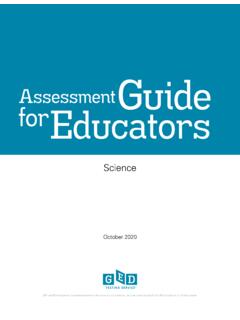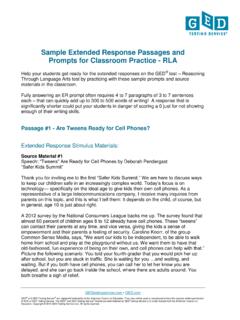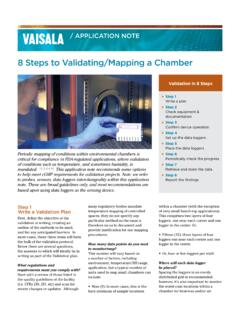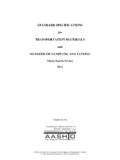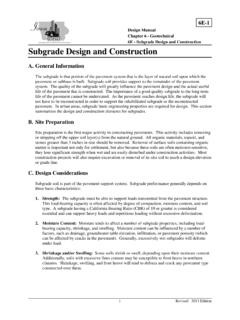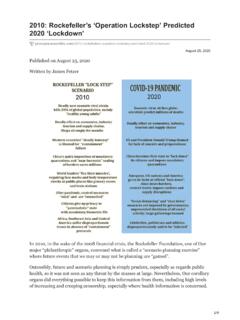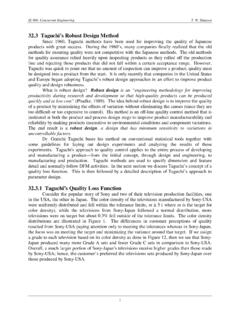Transcription of GED Study Guide - Classes, Online Practice Test, Study ...
1 6/15/2018 MyGED : Study #/ Study / Guide /SCIENCE/print1/19 GED Study GuideSCIENCEWhat you need to know about the GED Science Test 1 You should be familiar with basic science concepts, but you're not expected to have in-depth knowledge of each topic. Remember, the science test is not a memorization test! You don t need to know the entire periodictable of elements or the number of bones in the human 'll need to understand science concepts, use logic and reasoning to interpretinformation, and draw conclusions (which is using your critical thinking skills in science). This Study Guide and the example questions in it will help you get an idea of what s going to be onthe don t need to know everything in this Guide ! If you want to see how close you are to passing, the GED Ready official Practice test is a greatway to help you determine if you re ready. Test OverviewTopics Reading for Meaning in Science Designing and Interpreting Science Experiments Using Numbers and Graphics in ScienceTime (to take the test) 90 minutes No BreaksFormat Calculator Allowed Access to calculator reference sheet Multiple choice and other question types (fill in the blank, drag and drop, hot spot, anddrop down)What you'll be tested onThe GED test will measure your strength in the skills below.
2 Click on a skill to learn more about : Study #/ Study / Guide /SCIENCE/print2/196/15/2018 MyGED : Study #/ Study / Guide /SCIENCE/print3/19 Reading for Meaning in Science1 Claims and evidence in scienceYou'll be presented with science passages and be asked to:Find evidence that supports a findingMake sense of information that differs between various science sourcesScience readings often discuss theories or draw conclusions from evidence that ispresented. You should be able to read science passages and identify the evidence thatsupports the theory, principle, or conclusion that has been example, global climate change is a science topic that is frequently discussed in thenews. Articles about this topic generally present evidence as to how humans either are orare not responsible for the changing climate. It's important for you to be able to readsomething about climate change and identify the evidence that the authors cite to supporttheir QuestionsClaims and evidence in science Two chemists are designing instant hot and cold packs for a sports medicine supplycompany.
3 Their design uses chemicals that react with water to either heat up or cooldown the water inside the packs. They are investigating the reaction of ammoniumchloride with water to determine whether it is exothermic or A read a Study done recently by the National Institute for Standards andTesting, which reported that kilojoules of energy are absorbed by 100 grams ofammonium chloride when it is mixed with water. Chemist B measured thetemperature of the water in which the reaction takes place before and after thereaction. The results are displayed in the : Study #/ Study / Guide /SCIENCE/print4/19 Question:Does Chemist B's results support or contradict the evidence reported by Chemist A?You may use the B's results supports Chemist A's data because the reactiongains less energy than the water B's results contradicts Chemist A's data because it indicatesthat the reaction gains energy instead of losing B's results contradicts Chemist A's data because it indicatesthat the temperature of the reaction should go up rather than B's results supports Chemist A's data because the lowertemperature of the water indicates that energy is absorbed by : Study #/ Study / Guide /SCIENCE/print5/192 Science vocabulary, terms, and phrasesYou'll be shown different science passages and visuals and asked to:Understand and explain information from the passagesUnderstand symbols, terms, and phrases in scienceUse scientific words to express science informationScience readings often use special vocabulary and include elements such as charts andgraphs in addition to standard text.
4 You should be able to read and explain what isdiscussed in a science passage including the different text and graphic elements that mightbe 'll see questions that use common science symbols, terms, and phrases, such asdegree signs, atomic element symbols, and scientific formulas. You'll also see commonscientific example, a science passage about the causes of earthquakes might include specialgeology terms or concepts like plate tectonics. It might also include maps showingearthquake activity and charts that describe quake intensity in addition to the text should be able to take all of these elements and understand and describe the keymessages that the passage is trying to example: in the molecular structure CO + HO HCO you will not need to know that CO is carbon dioxide or HO is water, but you will need tobe familiar with the idea that these are representations of two distinct substances, whichwhen combined (+), form a new substance ( ) (carbonated water).
5 A third example: understanding the difference between a theory, a hypothesis, and ascientific law will help you determine when you can draw conclusions and when you willneed more QuestionsScience vocabulary, terms, and phrasesAbout billion years ago, the lower atmosphere had almost no oxygen. It was longbefore plants existed to produce oxygen. However, in the upper atmosphere, oxygencan be produced when carbon dioxide is split by sunlight into carbon monoxide examined 11 ancient micrometeorites, all older than billion years old,and discovered that most of them had once been particles of iron mixed with order for that to happen, there had to be almost as much oxygen in the upperatmosphere as there is now. The scientists say that the new information about theupper atmosphere does not change what they know about the lower : Study #/ Study / Guide /SCIENCE/print6/19 Question:Which statement accurately summarizes the passage?
6 Micrometeorite analysis proves that billion years ago, there wasno oxygen in the lower atmosphere or the upper analysis proves that billion years ago, there wasoxygen in the lower atmosphere but not in the upper analysis proves that billion years ago, there wasoxygen in the upper atmosphere but not in the lower analysis proves that billion years ago, there wasoxygen in both the lower atmosphere and the upper : Study #/ Study / Guide /SCIENCE/print7/19 Designing and Interpreting Science Experiments1 Science investigationsYou'll be asked to:Design a science investigationIdentify and explain independent and dependent variablesIdentify and improve hypotheses for science investigationsIdentify possible errors in a science investigation and change the design to correctthemIdentify the strengths and weaknesses of different types of science investigationsKey principles of science investigations include using and recording data, developing ahypothesis, setting up experiments, identifying controls and variables, and drawingconclusions.
7 You will be asked to evaluate investigations that may or may not have flaws inone or more of these 'll also evaluate and improve a hypothesis, or make a prediction about the outcome of ascience investigation that can be tested. You will be asked to determine the independentvariables (those that can be changed or controlled in a scientific experiment) anddependent variables (things that are changed by the independent variable).In the passage below, you will see the key principles of science lakes in a town have recently begun developing significant amounts of algae which arepreventing people from enjoying recreational activities on them. Environmental scientistsare brought in to determine the origin of the algae. They develop a hypothesis that thephosphorus content of the fertilizers used in nearby parks are stimulating excess algaegrowth. The scientists decide to discontinue the fertilizer at one of the local parks.
8 Theythen measure and record algae growth for four months at the lake near a park wherefertilizer use continues (control group) and the lake near another park where fertilizer hasbeen discontinued (changing the variable of phosphorus fertilizer). After four months, theyobserve that the algae has markedly decreased at the lake no longer using fertilizer. Theyconclude that the phosphorus fertilizer was the origin of the excess algae growth anddiscontinue its this example, you won't need to know anything about algae growth, lakes, or question will focus on whether the information presented to you supports the principlesof a good science example:6/15/2018 MyGED : Study #/ Study / Guide /SCIENCE/print8/19If calcium supplements are believed to reduce bone thinning, an experiment might becreated to give different groups of people differing dosages of calcium over an extendedtime. The independent variable would be the ingested dosage (including a control grouptaking no calcium) and the dependent variable would be the resulting bone you are conducting this science investigation, you would want different groups of peopleingesting different dosage amounts.
9 It would also be critical to have a control group thathas not ingested calcium supplements. The results of the control group would benecessary to compare with the groups consuming third example:Say you purchase two identical raspberry fruit plants. You give one to your neighbor toplant in his backyard and you plant the other in your backyard and at the same time. After afew weeks, you notice that your neighbor's raspberry plant is growing far more raspberriesthan yours. How would you figure out why your neighbor's plant is producing more fruit?An insufficient hypothesis would be: If I get lucky, then my plant will grow more cannot test that hypothesis because you can't control "getting lucky."However, a good hypothesis could be: If I give my plant fertilizer, it will grow as manyraspberries as my neighbor's plants. This is a testable QuestionsScience investigationsDissolved carbon dioxide gas (CO) creates carbonic acid in ocean water.
10 Risingocean acidity levels may harm marine life. For example, high acid levels may causehearing loss. Scientists conducted an investigation to Study the effect of increasedacidity on fish group of fertilized fish eggs from the same parents were divided into four differentaquariums, each with a different pressure of CO. One tank contained the normalatmospheric conditions of 390 microatmospheres of CO. The other tanks contained600, 700, and 900 microatmospheres of CO, respectively. The same number ofeggs was placed into each aquarium. The eggs hatched and the fish lived in theseaquariums until prepare for the experiment, one fish was placed into an aquarium containing thesame CO pressure in which it was raised. The fish's position was recorded every 5seconds for 2 minutes. Then sounds from a predatory fish were played from anunderwater speaker at one end of the aquarium at a volume that was only audible tothe fish when swimming near the speaker.



